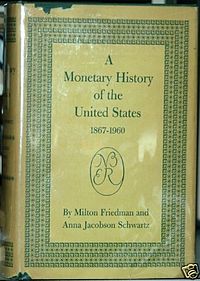- A Monetary History of the United States
-
A Monetary History of the United States, 1867-1960 
Dust jacket of 1st Edition, 3rd printingAuthor(s) Milton Friedman, Anna Schwartz Country USA Language English Subject(s) Economic history Genre(s) History Publisher Princeton University Press Publication date 1963 Media type Print (hardcover) Pages 860 pp (first edition) ISBN B000OL2K26 Dewey Decimal 332.4973 A Monetary History of the United States, 1867-1960 is a book written in 1963 by Nobel prize winning economist Milton Friedman and Anna J. Schwartz. It collects together historical data and economic analysis to argue the then novel proposition that changes in monetary policy (changes in the rate of growth of the money supply) profoundly influenced the US economy, especially the behavior of economic fluctuations.
Contents
Thesis
The book discusses the role of the monetary policy in the U.S. economy from the Civil War Reconstruction Era to the middle of the 20th century. It presents what was then a contrarian view of the role of monetary policy in the Great Depression. The prevalent view in the early 1960s was that monetary forces played a passive role in the economic contraction of the 1930s. The Monetary History argues that the bank failures and the massive withdrawals of currency from the financial system that followed, significantly shrank the money supply (the total amount of currency and outstanding bank deposits), which greatly exacerbated the economic contraction. The book criticizes the Federal Reserve Bank for not keeping the supply of money steady, and not acting as lender of last resort – instead they allowed commercial banks to fail and allowed the economic depression to deepen.[1]
According to Bernanke, (now Chairman of the Federal Reserve), Friedman and Schwartz identified four main policy mistakes made by the Federal Reserve that led to a sharp and undesirable decline in the money supply:[1]
- Tightening monetary policy (resulting in increasing interest rates) beginning in the spring of 1928 and continuing until the stock market crash of October 1929. This caused the economy to enter a recession in mid-1929, and triggered the stock market crash in October.
- Raising interest rates to defend the dollar in response to speculative attacks in September and October 1931, while ignoring the difficulties this caused to domestic commercial banks.
- Despite lowering interest rates early in 1932 with positive results, raising interest rates again in late 1932, causing a further collapse in the US economy.
- Ongoing neglect of problems in the U.S. banking sector throughout the early 1930s. The Federal Reserve failed to create a stable domestic banking environment by supporting the domestic banks and acting as lender of last resort to domestic banks during banking panics.
Influence
The book was the first to present the then-novel argument that excessively tight monetary policy by the Federal Reserve following the boom of the 1920s turned an otherwise normal recession into the Great Depression of the 1930s. Previously, the consensus of economists was that loss of investor and consumer confidence following the Wall Street Crash of 1929 were the primary causes of the Great Depression.
The chapter on the Great Depression, entitled "The Great Contraction, 1929-33", was published as a stand-alone paperback in 1965.[2]
The Monetary History was lauded as one of the most influential economics books of the twentieth century by the Cato Institute book forum in 2003.[3] and was cited with approval in a 2004 speech by then-Federal Reserve board member Ben Bernanke, as "transform[ing] the debate about the Great Depression".[1]
Notes
- ^ a b c Bernanke, Ben (March 2, 2004). "Money, Gold, and the Great Depression". Remarks by Governor Ben S. Bernanke at the H. Parker Willis Lecture in Economic Policy. Federal Reserve Board website. http://www.federalreserve.gov/boarddocs/speeches/2004/200403022/default.htm. Retrieved Aug 19, 2009.
- ^ "The Great Contraction, 1929-1933: (New Edition)". Princeton University Press. http://press.princeton.edu/titles/8754.html. Retrieved 2011-10-28.
- ^ "A Monetary History of the United States, 1867-1960". Archived Events, Book Forum. Cato Institute website. http://www.cato.org/events/031121bf.html. Retrieved June 15, 2008.
See also

This article about a book on economics or finance is a stub. You can help Wikipedia by expanding it.
